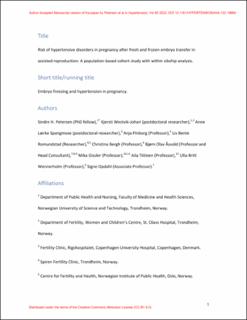| dc.contributor.author | Petersen, Sindre Hoff | |
| dc.contributor.author | Westvik-Johari, Kjersti | |
| dc.contributor.author | Spangmose, Anne Lærke | |
| dc.contributor.author | Pinborg, Anja Bisgaard | |
| dc.contributor.author | Romundstad, Liv Bente Bergem | |
| dc.contributor.author | Bergh, Christina | |
| dc.contributor.author | Åsvold, Bjørn Olav | |
| dc.contributor.author | Gissler, Mika | |
| dc.contributor.author | Tiitinen, Aila | |
| dc.contributor.author | Wennerholm, Ulla-Britt | |
| dc.contributor.author | Opdahl, Signe | |
| dc.date.accessioned | 2023-07-27T12:04:18Z | |
| dc.date.available | 2023-07-27T12:04:18Z | |
| dc.date.created | 2023-01-19T12:50:31Z | |
| dc.date.issued | 2022 | |
| dc.identifier.citation | Hypertension. 2022, 80 (2), e6-e16. | en_US |
| dc.identifier.issn | 0194-911X | |
| dc.identifier.uri | https://hdl.handle.net/11250/3081629 | |
| dc.description.abstract | Background:
Frozen embryo transfer (frozen-ET) is increasingly common because of improved cryopreservation methods and elective freezing of all embryos. Frozen-ET is associated with higher risk of hypertensive disorders in pregnancy than both natural conception and fresh embryo transfer (fresh-ET), but whether this is attributable to parental factors or treatment is unknown.
Methods:
Using the Medical Birth Registries of Denmark (1994–2014), Norway, and Sweden (1988–2015), linked to data from national quality registries and databases on assisted reproduction, we designed a population-based cohort study with within-sibship comparison. We included 4 426 691 naturally conceived, 78 300 fresh-ET, and 18 037 frozen-ET singleton pregnancies, of which 33 209 sibships were conceived using different conception methods. Adjusted odds ratios (aOR) of hypertensive disorders in pregnancy for fresh-ET and frozen-ET versus natural conception with 95% CI were estimated using multilevel logistic regression, where random effects provided conventional population-level estimates and fixed effects gave within-sibship estimates. Main models included adjustment for birth year, maternal age, parity, and country.
Results:
Risk of hypertensive disorders in pregnancy was higher after frozen-ET compared to natural conception, both at population-level (7.4% versus 4.3%, aOR, 1.74 [95% CI, 1.61–1.89]) and within sibships (aOR, 2.02 [95% CI, 1.72–2.39]). For fresh-ET, risk was similar to natural conception, both at population-level (aOR, 1.02 [95% CI, 0.98–1.07]) and within sibships (aOR, 0.99 [95% CI, 0.89–1.09]).
Conclusions:
Frozen-ET was associated with substantially higher risk of hypertensive disorders in pregnancy, even after accounting for shared parental factors within sibships. | en_US |
| dc.language.iso | eng | en_US |
| dc.publisher | American Heart Association | en_US |
| dc.rights | Navngivelse 4.0 Internasjonal | * |
| dc.rights.uri | http://creativecommons.org/licenses/by/4.0/deed.no | * |
| dc.title | Risk of Hypertensive Disorders in Pregnancy After Fresh and Frozen Embryo Transfer in Assisted Reproduction: A Population-Based Cohort Study With Within-Sibship Analysis | en_US |
| dc.title.alternative | Risk of Hypertensive Disorders in Pregnancy After Fresh and Frozen Embryo Transfer in Assisted Reproduction: A Population-Based Cohort Study With Within-Sibship Analysis | en_US |
| dc.type | Peer reviewed | en_US |
| dc.type | Journal article | en_US |
| dc.description.version | acceptedVersion | en_US |
| dc.source.pagenumber | e6-e16 | en_US |
| dc.source.volume | 80 | en_US |
| dc.source.journal | Hypertension | en_US |
| dc.source.issue | 2 | en_US |
| dc.identifier.doi | 10.1161/HYPERTENSIONAHA.122.19689 | |
| dc.identifier.cristin | 2110317 | |
| dc.relation.project | Andre: NF17043 | en_US |
| dc.relation.project | Andre: NF16026 | en_US |
| dc.relation.project | Andre: NF15058 | en_US |
| dc.relation.project | Andre: NF13041 | en_US |
| dc.relation.project | Norges forskningsråd: 262700 | en_US |
| dc.relation.project | Helse Midt-Norge: 46045000 | en_US |
| dc.relation.project | Norges teknisk-naturvitenskapelige universitet: 81148215 | en_US |
| dc.relation.project | Nordforsk: 71450 | en_US |
| dc.relation.project | Nordisk ministerråd: 71450 | en_US |
| cristin.ispublished | true | |
| cristin.fulltext | postprint | |
| cristin.qualitycode | 2 | |

